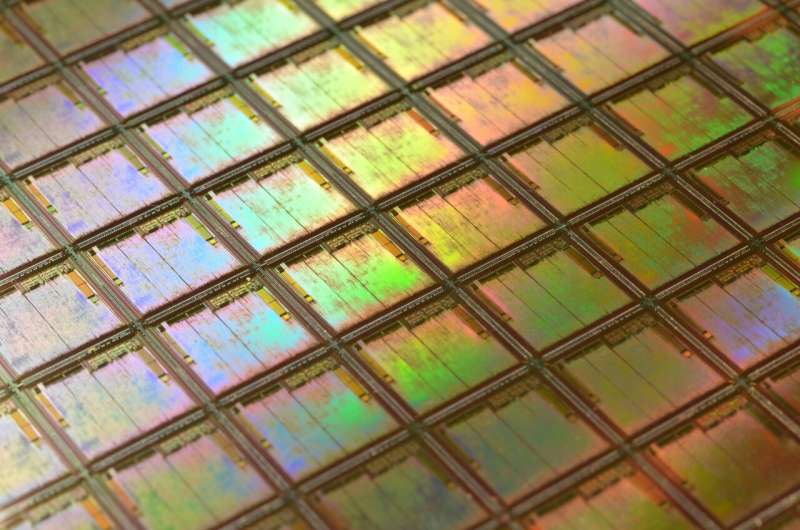This article has been reviewed according to Science X's editorial process and policies. Editors have highlighted the following attributes while ensuring the content's credibility:
fact-checked
peer-reviewed publication
proofread
Researchers achieve unprecedented nanostructuring inside silicon

Silicon, the cornerstone of modern electronics, photovoltaics, and photonics, has traditionally been limited to surface-level nanofabrication due to the challenges posed by existing lithographic techniques. Available methods either fail to penetrate the wafer surface without causing alterations or are limited by the micron-scale resolution of laser lithography within Si.
In the spirit of Richard Feynman's famous dictum, "There's plenty of room at the bottom," this breakthrough aligns with the vision of exploring and manipulating matter at the nanoscale. The innovative technique developed by a Bilkent University team surpasses current limitations, enabling controlled fabrication of nanostructures buried deep inside silicon wafers with unprecedented control.
The work appears in Nature Communications.
The team tackled the dual challenge of complex optical effects within the wafer and the inherent diffraction limit of the laser light. They overcome these by employing a special type of laser pulse, created by an approach called spatial light modulation. The non-diffracting nature of the beam overcomes optical scattering effects that have previously hindered precise energy deposition, inducing extremely small, localized voids inside the wafer.
This process is followed by an emergent seeding effect, where preformed subsurface nano-voids establish strong field enhancement around their immediate neighborhood. This new fabrication regime marks an improvement by an order of magnitude over the state-of-the-art, achieving feature sizes down to 100 nm.
"Our approach is based on localizing the energy of the laser pulse within a semiconductor material to an extremely small volume, such that one can exploit emergent field enhancement effects analogous to those in plasmonics. This leads to sub-wavelength and multi-dimensional control directly inside the material," explained Prof. Tokel. "We can now fabricate nanophotonic elements buried in silicon, such as nanogratings with high diffraction efficiency and even spectral control."
The researchers used spatially-modulated laser pulses, technically corresponding to a Bessel function. The non-diffracting nature of this special laser beam, which is created with advanced holographic projection techniques, enables precise energy localization. This, in turn, leads to high-temperature and pressure values enough to modify the material at a small volume.
Remarkably, the resulting field enhancement, once established, sustains itself through a seeding type mechanism. Simply put, the creation of earlier nanostructures helps fabricate the later nanostructures. The use of laser polarization provides additional control over the alignment and symmetry of nanostructures, enabling the creation of diverse nano-arrays with high precision.
"By leveraging the anisotropic feedback mechanism found in the laser-material interaction system, we achieved polarization-controlled nanolithography in silicon," said Dr. Asgari Sabet, the study's first author. "This capability allows us to guide the alignment and symmetry of the nanostructures at the nanoscale."
The research team demonstrated large-area volumetric nanostructuring with beyond-diffraction-limit features, enabling proof-of-concept buried nano-photonic elements. These advances have significant implications for developing nano-scale systems with unique architectures.
"We believe the emerging design freedom in arguably the most important technological material will find exciting applications in electronics and photonics," said Tokel. "The beyond-diffraction-limit features and multi-dimensional control imply future advances, such as metasurfaces, metamaterials, photonic crystals, numerous information processing applications, and even 3D integrated electronic-photonic systems."
"Our findings introduce a new fabrication paradigm for silicon," concluded Prof. Tokel, "The ability to fabricate at the nano-scale directly inside silicon opens up a new regime, toward further integration and advanced photonics. We can now start asking whether complete three-dimensional nano-fabrication in silicon is possible. Our study is the first step in that direction."
In addition to Sabet and Tokel, the research team consists of Aqiq Ishraq, Alperen Saltik and Mehmet Bütün, all affiliated with the Department of Physics and the National Nanotechnology Research Center at Bilkent University. Their expertise spans various fields, including optics, materials science, and nanotechnology.
More information: Laser nanofabrication inside silicon with spatial beam modulation and anisotropic seeding, Nature Communications (2024). DOI: 10.1038/s41467-024-49303-z. www.nature.com/articles/s41467-024-49303-z
Journal information: Nature Communications
Provided by Bilkent University




















